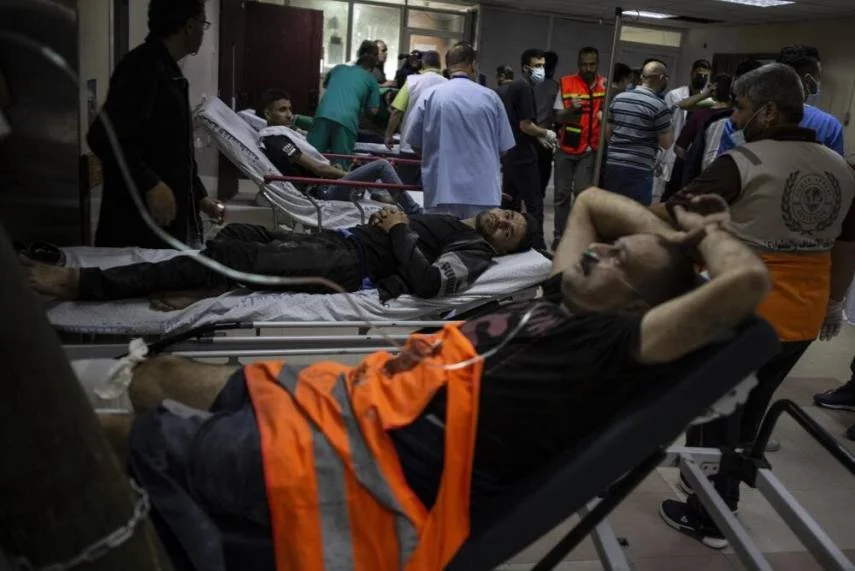
Gaza City- The Gaza Strip”s already feeble health system is being brought to its knees by the fourth war in just over a decade.
Hospitals have been overwhelmed with waves of dead and wounded from Israel”s bombardment. Many vital medicines are rapidly running out in the tiny, blockaded coastal territory, as is fuel to keep electricity going.
Two of Gaza”s most prominent doctors, including the No. 2 in Gaza”s coronavirus task force, were killed when their homes were destroyed during barrages since fighting between Hamas and Israel erupted 10 days ago.
Just as Gaza was climbing out of a second wave of coronavirus infections, its only virus testing lab was damaged by an airstrike and has been shut down. Health officials fear further outbreaks among tens of thousands of displaced residents crammed into makeshift shelters after fleeing massive barrages.
At one UN-run school where 1,400 people were taking shelter, Nawal al-Danaf and her five children were crammed into a single classroom with five other families. Blankets draped over cords crisscrossed the room to carve out sleeping spaces.
“The school is safe from the war, but when it comes to corona, with five families in a room, everyone infects each other,” said al-Danaf, who fled Israeli tank shelling on the northern Gaza town of Beit Lahiya a few days ago.
Blankets and laundry dangled from the railings of the school”s balcony, as women looked down into a yard where children were playing and men sat chatting. No one wore a mask or could do any social distancing in the cramped quarters.
The Gaza Strip”s health infrastructure was already collapsing before this latest war, said Adnan Abu Hasna, a media adviser for UNRWA, the U.N. agency that provides vital assistance to the 75% of the enclave”s population who are refugees. “It”s frightening,” he said.
The sector has been battered by three previous wars between Israel and Gaza”s Hamas rulers. In each round of fighting, hospitals and clinics were damaged or destroyed, and medical personnel killed. And after each, authorities had to slowly rebuild, hampered by the blockade imposed by Israel and Egypt since Hamas took power in 2007.
Other turmoil also weighed on the system. More than two years of weekly Friday Palestinian protests at the border with Israel against the blockade produced a constant stream of casualties from Israeli fire — more than 35,000 injured, many with lifelong disabilities and around 100 still awaiting reconstructive surgery and amputations.
Now health facilities are struggling to handle both the casualties of war and the everyday needs of Gaza”s 2 million people.
“It”s layer-upon-layer of crisis. And there never is really enough time between each crisis to rebuild,” Schmale said.
“The (health care) system has gradually been quite significantly weakened. I wouldn”t say it”s on its knees, but getting close.”
Since the current conflict started, Israel has struck hundreds of targets across the Mediterranean coastal strip. Israel says it is trying to cripple Hamas, which has fired hundreds of rockets into Israel.
Gaza health officials say at least 227 Palestinians, including 64 children, have been killed in airstrikes and more than 1,600 wounded. Twelve people in Israel have been killed by rockets.
The bombardment has driven more than 56,000 Gazans from their homes, fleeing into 59 schools run by UNRWA. The U.N. agency is providing them with water and basic hygiene supplies, including face masks. Unknown numbers more have taken refuge with relatives.
UNRWA learned from the last war, in 2014, when some 292,000 displaced people crammed into its schools and other shelters during 50 days of fighting. Since then, the agency has installed showers, more bathrooms and extra water and electricity capacity into some of the schools in case they might be needed again for shelters, officials said.
So far, the current onslaught has not been as directly destructive to health facilities as 2014, when multiple hospitals and clinics took direct hits from Israeli bombing, as did UN schools housing the displaced. (AP)
Follow this link to join our WhatsApp group: Join Now
Be Part of Quality Journalism |
Quality journalism takes a lot of time, money and hard work to produce and despite all the hardships we still do it. Our reporters and editors are working overtime in Kashmir and beyond to cover what you care about, break big stories, and expose injustices that can change lives. Today more people are reading Kashmir Observer than ever, but only a handful are paying while advertising revenues are falling fast. |
| ACT NOW |
| MONTHLY | Rs 100 | |
| YEARLY | Rs 1000 | |
| LIFETIME | Rs 10000 | |











